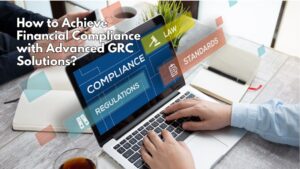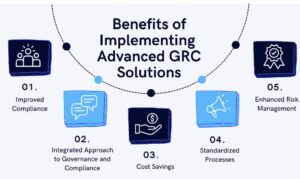Compliance is key to success in the finance industry. In an era when regulatory change has entered uncharted waters and the cost of non-compliance can be crippling, financial institutions need to act in their best interests to protect their reputation and bottom line.
GRC offers sophisticated solutions for managing compliance, guiding customers through complex landscapes to meet all stipulated requirements.

Image Source: Canva
Why Compliance Matters
In the finance industry, compliance with regulations pertains to more than just the law but also to the domain of trust and integrity in the entire financial system.
Consistent and effective financial compliance management ensures that institutions operate within legal and ethical boundaries, thereby avoiding costly fines and damage to their reputation. It also ensures that there is protection in the interest of the customer, providing market confidence and preserving the stability of the financial system.
Legal Framework
Regulatory mechanisms that govern financial institutions include the Sarbanes-Oxley Act, the Dodd-Frank Act, the General Data Protection Regulation, and anti-money laundering legislation in the business setup.
Noncompliance may have consequences, majorly including heavy penalties, legal actions, or loss of business licenses. In addition, it can mar the whole reputation an institution has, being irreparable, hence will lead to customers not trusting them and a loss in market value.
Offering Solutions
Established GRC solutions drive compliance by creating an integrated framework for managing risks and regulatory demands. These solutions bring together many elements of governance, risk management, and compliance into a single system that an organization uses to track and manage its compliance activities.
Advanced GRC solutions enable financial institutions to make their compliance processes more efficient, reduce the risk of non-compliance, and stay ahead of new and changing regulations.
The Various Components of Advanced GRC Solutions
Advanced GRC solutions include different components to deal with diversified classes of governance, risk management, and compliance. The following components are the basic entities that work closely to offer a combined approach to compliance with financial value.
1. Risk Management
It is all about identifying, assessing, and treating anything that might prohibit organizations from managing compliance effectively. In risk assessment, advanced GRC solutions have potent capabilities that an organization can exploit in identifying potential risks and vulnerabilities.
These tools leverage data analytics and predictive modeling techniques to evaluate the likelihood and impact of different risks on an organization, demonstrating ways to proactively mitigate risks.
2. Regulatory Compliance
GRC solutions are basically designed around the issue of regulatory compliance. They avail very comprehensive regulatory libraries in a continuously updated system to be on top of any changes in the regulatory requirements.
This gives an organization a leeway never to miss out on the latest changes in the regulatory requirements. GRC solutions also enable tracking and reporting over the many different compliance activities by automating the solution and incorporating the improved reporting tool.
3. Policy Management
Irrespective of the component, policy management is a significant area in GRC solutions. It is part of the process of creating, distributing, and enforcing policies and procedures according to the regulations.
Cutting-edge GRC solutions provide mechanisms for policy creation and revision, enabling quick implementation and dissemination among employees while maintaining compliance consistency. It also brings accountability and transparency in policy compliance through tracking policy changes and acknowledgment by employees.
4. Incident Management
Incident management is the key to fixing compliance breaches and other incidents that can affect an organization’s compliance status. GRC solutions entail incident management tools to be utilized for logging, investigating, and resolving an incident in a timely matter.
The tools provide workflows in the control processes of investigating incidents, tracking corrective actions, and generating reports. Effective incident management reduces the impact of compliance breaches and establishes checkpoints to monitor violators.
5. Audit Management
Audit management is critical to the conformity of financial regulations. GRC solutions have audit management tools that help in the planning, performing, and recording of audits. Its features include audit scheduling, risk-based plans for auditing, and ways of auditing.
Other tools entail automated means of auditing and full audit reports which a team can use to identify any loopholes in compliance and act as corrective measures. Audit management tools help ensure that the compliance activity of the organization is effective and that the organization is prepared against regulatory inspections.
Benefits of Implementing Advanced GRC Solutions
The advantages of implementing advanced GRC solutions are the following:

Image Source: Canva
1. Improved Compliance
Advanced GRC solutions help in creating a framework that seeks to manage compliance across an organization, dealing with all regulatory requirements. It does so by the automated compliance monitoring mechanism and reporting tools, which streamline the compliance process and reduce the risk of non-compliance.
2. Enhanced Risk Management
GRC has advanced tools for risk assessment that help the organization be set for risk identification and mitigation. A proactive way of risk management is going to prevent potential breaches of compliance, thus protecting the reputation of an organization.
3. Standardized Processes
GRC solutions bring together several components of governance, risk management, and compliance together at one place. Thus, companies can easily focus their management of compliance in one place. An integrated solution would offer standardized processes combined with automation functionality to make sure that compliance performance for all activities is carried out in a much more integrated and streamlined way.
4. Integrated Approach to Governance and Compliance
GRC solutions come equipped with data analytical and reporting tools, which provide valuable insights with respect to various compliance activities. It helps the organization decide on its activities for deriving better outcomes with regard to compliance measures.
5. Cost Savings
These GRC solutions help organizations realize great savings in terms of the costs saved on fines, legal actions, and possible damage to the reputation through the reduction of the risks of non-compliance and streamlining the GRC process, all the while reducing the involved risks. By this, they improve their operational efficiencies and then save on costs in the long run.
Best Practices to Implement an Advanced GRC Solution
The implementation of an advanced GRC solution has been regarded as a cautious exercise. Here are some best practices to successfully implement an advanced GRC solution:
1. Define Clear Objectives of GRC
Before implementing GRC solutions, organizations have to define clear goals for their compliance efforts. Goals should specify the regulatory requirements to be complied with and should be measurable, with well-defined objectives for compliance activities.
2. Involve Key Stakeholders
Proper implementation of GRC solutions would be highly reliant on the involvement of, and the active role played by, the key stakeholders, such as the compliance officers, risk managers, IT personnel, and top management. These stakeholders need to have a stake in the planning and decision process so that the deployment of GRC solutions becomes something that matches the requirements of the organization at different levels.
3. Risk Assessment
Organizations should go through a complete risk assessment identifying possible risks and their most vulnerable areas. It includes an analysis of all possible risks and chances of occurrence along with the impact and needed mitigation measures.
4. Compliance Framework Development
A compliance framework includes the development of appropriate policies and procedures in accordance with legal and regulatory requirements. Additionally, organizations should develop roles and responsibilities for employees performing compliance activities and a monitoring and reporting system to measure compliance efforts.
5. Provide Training and Awareness
The organization needs to ensure training and awareness to let the employees understand the compliance responsibility and the importance of policies and procedures. Organizations should take time to communicate the requirements for compliance to all other employees.
6. Monitor and Evaluate
Monitor and always assess the effectiveness of these attempts at compliance. This should be done through the tracking of compliance activities, regular audits, and the assessment of the effectiveness of the plan for risk management. Besides, one must have to be able to adjust the organization’s compliance efforts to deal with new risks and new regulatory requirements.
FAQs
- Why is financial compliance a part of management?
Financial compliance management is the process of ensuring institutions in the financial sector abide by regulatory requirements and industry standards. It encompasses putting policies and procedures into place, monitoring activities for compliance, and managing risks in a manner that will avoid non-compliance.
- How can GRC solutions help with financial compliance?
GRC solutions provide a comprehensive framework for managing financial compliance. They offer tools for risk assessment, policy management, regulatory compliance, incident management, and audit management. These solutions help organizations streamline their compliance processes, reduce the risk of non-compliance, and stay ahead of regulatory changes.
- What are the benefits of using advanced GRC solutions?
Advanced GRC solutions provide improved compliance, enhanced risk management, streamlined work processes, better decision-making, and cost savings. Holistic compliance solutions ensure the meeting of regulatory requirements and the protection of organizational reputation.
Conclusion
Financial compliance is absolutely necessary for the success and sustainability of financial institutions. Therefore, Advanced GRC solutions provide an organized framework for managing compliance, governance, and risk management.
Implementing GRC solutions requires careful planning and execution, but the long-term gains far outweigh the challenges. Such solutions can aid an organization in negotiating the complex regulatory environment, reducing the risk of non-compliance and hence protecting the reputation of firms. Compliance can be properly managed and secured with the existence of financial institutions within the industry.



